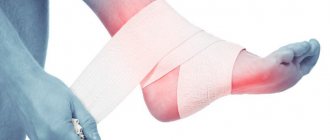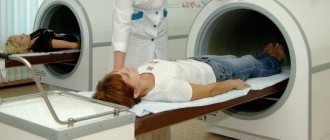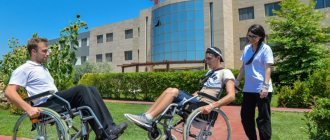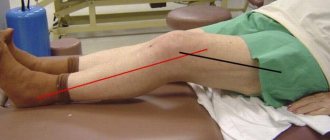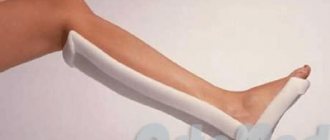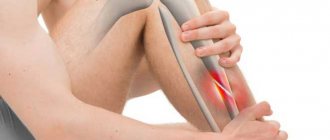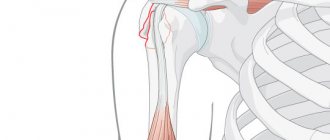A fracture of the lower limb is a fairly serious injury that requires long-term therapy and rehabilitation. It is accompanied not only by severe pain and bone deformation, but also by the appearance of swelling. Everyone who has encountered this injury needs to know how to relieve swelling after a broken leg.
By edema, doctors mean the accumulation of fluid in the soft tissues surrounding the bone tissue. The appearance of swelling is due to the fact that blood flow in the injured limb is disrupted.
Primary edema often appears immediately after injury to a limb. Secondary ones can occur after removal of the plaster, when the integrity of the bones and surrounding tissues is completely restored. But prolonged lack of physical activity and being in a cast have a detrimental effect on blood flow and lymph outflow, which actually causes swelling during the rehabilitation period.
Often, swelling can appear when the ankle or heel bone is damaged. They are quite difficult to treat. In the case of these injuries, swelling can be caused not only by deterioration of lymph and blood flow, but also by damage to the surrounding soft tissue.
Swelling is accompanied by severe aching and bursting pain. In addition, it is accompanied by the appearance of a hematoma and changes in the color of the skin around the broken bone. If the fracture is complicated by the presence of fragments, then swelling can be localized not only at the site of injury, but also affect the entire lower limb.
Exercise therapy and massage
Therapeutic techniques that help relieve leg swelling due to a fracture, first of all, consist of methods that help normalize blood flow in damaged tissues. You can start using them immediately after applying a plaster cast.
Therapeutic exercises and massage can help relieve swelling. From the first days, doctors advise doing light exercises, starting to work out the leg from the toes. But it’s also worth considering that you can’t put any stress on the fracture site at first. As the bone heals and the tissue is restored, it is necessary to systematically increase the intensity of physical activity.
If, while performing therapeutic exercises, the patient begins to notice that the injured leg hurts and swells, the number of exercises should be slightly reduced. When the fracture begins to heal, the doctor will select the necessary exercises and their quantity in order to stimulate blood flow and reduce swelling in the injured leg.
Massaging muscle areas after a fracture helps improve blood flow, eliminate lymph congestion and quickly restore damaged tissue. You can entrust this procedure to a massage therapist or learn massage yourself. In addition to this procedure, the traumatologist often prescribes hydromassage sessions performed by a specialist in the traumatology rehabilitation department.
Limb massage should begin from the fingertips, moving to the proximal part of the leg. Movements should be stroking and gentle. Next, you should move on to rubbing and kneading the muscle areas free from the plaster cast. It is impossible to massage a fracture so as not to displace bone fragments and not lead to excessive growth of callus at the fracture site.
You should not massage the popliteal area, since it contains large regional lymph nodes, which can increase swelling and worsen the general condition of the patient. Massage procedures can be carried out with special absorbable and anti-inflammatory gels. After the doctor removes the plaster, massage must be done daily in order to prevent atrophy of the muscular system, which has been without movement and stress for a long time. If massage procedures and therapeutic exercises cause discomfort, they can be performed by lowering the injured limb into a basin of water at a comfortable temperature.
Treatment of complications after fractures
We talk about the treatment of complications after fractures, which include: pseudarthrosis, nonunion fractures and chronic injuries, as well as improperly healed periarticular fractures.
At the Scandinavia clinic it is possible to examine
and promptly treat patients who have either long-term non-union fractures, or complex joints due to surgical interventions, or chronic or improperly healed fractures.
What is done in this case? Firstly, the clinic has the opportunity to examine the patient: MRI, X-ray and everything else. Secondly, the clinic has a sufficient range of metal structures. In addition to the ability to treat emergency patients with fresh trauma, the clinic can also treat and perform operations on patients who have long-term consequences or problems after injuries. These include: pseudarthrosis, non-united fractures, malunited fractures, fractures of metal structures on non-united fractures. The problem is that any fracture, when healing, goes through certain phases. Why does false joint occur? Either the fragments are positioned incorrectly - there is no contact between the fragments, or surgical treatment was performed, but there was insufficient reposition, or other technical problems.
Examination in a hospital setting
More details
There are fractures, the location of which will not greatly affect the future life and function of the limbs, with which you can, in principle, do nothing, even if they have healed incorrectly. Well, maybe there is a cosmetic defect. But there are fractures (these include mainly periarticular and intra-articular fractures) that cannot be left in this form and something needs to be done with them in order for the person to continue to live fully functionally.
The clinic's doctors also operate on false joints, including bone grafting, using the same latest metal structures and techniques that are used all over the world. The clinic also operates on improperly healed fractures,
replacement of metal structures with correction of the axis of the limb, with correction of the position of fragments inside the joint. There are intra-articular fractures that require endoprosthetics, which cannot be restored using simple methods. In this situation, endoprostheses of the knee, hip, and shoulder joints are used, followed by rehabilitation in a clinic, which is possible until complete recovery.
From time to time, patients come to the clinic with old injuries that are in this condition: not healed - not healed, it’s unclear, for example, there is no support on the leg, if it is a fracture of a large bone, the tibia or near the femoral neck. They are mostly bedridden, and city clinics often refuse to help them because they do not have the ability to provide sufficient treatment for concomitant pathologies. These are predominantly older patients and patients with neck fractures, pertrochanteric fractures, and even chronic ankle fractures. They require surgical treatment, but in the conditions of a very qualified anesthesiological team and quite serious rehabilitation. This is what the doctors at the clinic do: they synthesize these fractures and put everything in place as it should be. Sometimes this is due to technical difficulties, but the clinic has an orthopedic table, which helps with this, and an X-ray machine, with the help of which all actions are monitored during the operation.
Arthroscopy Center
surgical treatment of joint diseases
Even if it was a very old fracture, doctors try to get the patient back on his feet literally the next day after the operation. The implants and technology used make this possible, and the therapeutic and anesthetic support makes it possible to activate them very quickly.
There is also such a problem as false joints - these are non-union fractures, the non-union of which lasts more than six months. That is, we are talking about a double or triple period of typical healing; if during this time the fracture does not heal, a false joint forms at this place. The problem is that it will never heal on its own after this, will always be mobile and will cause inconvenience.
Such problems arise both after previous operations and without surgical treatment. The main task in such a situation is to create conditions for fusion. This involves stabilizing and irritating the fracture area or transplanting your own bone there in order to stimulate healing of the fracture. Such operations have been performed in the clinic many times with good results and early rehabilitation.
One of the consequences of injuries is improperly healed fractures. This occurs either due to incorrect immobilization, or even due to failure to see a doctor about the fracture. It happens that with inadequate load, the metal structure that fixes the fracture breaks, and the fracture heals in the wrong position. If this is a supporting bone (for example, a weight-bearing leg), it is impossible to live with it; this is a curvature of the limb, which leads to problems above and below the fracture. In this situation, surgery is necessary. If a metal structure was previously installed there, it is removed, the limb axis is restored with minimal loss of local tissue and is also fixed in this way
way so that you can start loading this limb as early as possible.
Installment plan for all clinic services
For those who are more comfortable paying in installments
The greatest danger is posed by improperly healed periarticular fractures, because they ultimately lead to severe arthrosis. Even at a young age, if a fracture of the tibia heals incorrectly, arthrosis of the ankle and knee joints appears, so such things must be corrected. Maybe outwardly it doesn’t look so scary, but after 3-5 years problems will begin in the fracture zone above and below. The operation is carried out precisely in order to quickly rehabilitate and continue living a full life.
You can make an appointment with a doctor by phone or online.
Date of publication: 04/27/16
Physiotherapy
Physiotherapy has a good effect on edema. But we should not forget that the procedures do not help immediately, but gradually, so to obtain the desired result you will have to be patient. Magnetic therapy to relieve swelling can be done even through a plaster cast. The remaining physiotherapeutic procedures are carried out after the plaster is removed.
In order to relieve swelling, they often use:
- Myostimulation.
- Electrophoresis with absorbable gel.
- Applications with paraffin and ozokerite.
- Phonophoresis.
- Treatment with an ultraviolet lamp.
Possible consequences and complications
Edema and swelling in the lower limb is a dangerous complication. A medical error or problems with the circulatory and lymphatic systems can lead to complete loss of a limb due to obstructed blood circulation.
A dangerous complication is also possible – vein thrombosis. This disease is characterized by the appearance of blood clots that clog blood vessels. Blockage can occur not only in the lower limb area, but in any area.
Swelling in the lower extremities is a dangerous condition that significantly impairs the quality of life due to itching and pain in the legs. This reaction of the body can be caused by pathologies of the circulatory or lymphatic systems, as well as non-compliance with the regime or an incorrectly fixed plaster cast.
Medicines
Medications will also help reduce swelling during a fracture. Traditional decongestant therapy consists of the use of various ointments and gels to relieve swelling, inflammation and resolve hematomas. This treatment is aimed at improving blood flow and eliminating congestion in damaged tissues.
For this purpose, heparin-based gels containing non-steroidal anti-inflammatory components are used, for example Diclofenac and Ortofen. Their analgesic and anti-edematous effect consists of blocking mediators that cause inflammatory processes. Using the gel drug Troxevasin, you can strengthen the vascular walls, thus relieving the swelling of the affected tissues. The above-described drugs can be used only after consultation with a surgeon or traumatologist.
Drug therapy is prescribed in the first few days after the fracture. Then the traumatologist can prescribe warming and absorbable applications containing ichthyol ointment. It can also be rubbed into the skin around the damaged area until completely absorbed. The duration of treatment is determined by the doctor. Read more about ointments for fractures here.
Hip fracture: recovery time at home and in hospital
Patients with such trauma often remain in the hospital for a long time. Here they are provided with professional care. Relatives usually hire a caregiver. Her tasks include monitoring the patient’s condition, following the doctor’s recommendations, changing a diaper in case of a hip fracture, organizing meals, etc. The nurse does similar work at home.
The recovery time of the patient depends very conditionally on his place of stay. The quality of care plays a big role. If it is properly organized and constant, the average prognosis for restoring walking skills is six months.
ethnoscience
If you don’t know how to relieve swelling after a broken leg, try doing it using folk remedies, but before doing this, be sure to consult a doctor.
Traditional therapy aimed at reducing swelling often takes quite a long time, so in order to speed up this process in combination with it, you can use folk recipes whose effectiveness has been tested by time. Unfortunately, the use of folk remedies does not have a scientific evidence base.
After removing the plaster cast, you can rub essential oils into the fracture area. Fir oil is best suited for this purpose. To avoid burning the skin, it must be diluted with neutral oil, for example, massage oil. This mixture is suitable for both massage procedures and compresses. Coniferous oil concentrate allows not only to warm damaged tissues, but also to accelerate regenerative processes and blood flow.
Clay applications are also great for dealing with swelling. To do this, you can use any cosmetic clay that is sold in a pharmacy. Blue clay is often used in decongestant compresses. To make such a compress, you need to apply clay diluted with water to the affected area and cover it with a film, leaving the compress for an hour. Thus, it is necessary to be treated until the swelling disappears completely.
You can also make lotions from arnica infusion. To prepare it, take 3 tablespoons of this plant and add boiling water, leaving the infusion for an hour. Then soak gauze in it and apply it to the affected leg for thirty minutes. It is recommended to conduct treatment sessions before going to bed. Foot baths with the addition of salt and horsetail relieve swelling. You can apply a leaf of burdock or white cabbage to the site of swelling.
Using all of the above methods, you can get rid of swelling much faster and reduce the rehabilitation period after injury. Be healthy.
